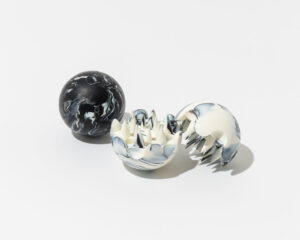For those who work, train, and explore in the planet’s most brutal climates, clear vision isn’t optional—it’s critical. On glaciers, where sunlight ricochets off snow and ice at high intensity, typical eyewear fails. Conventional lenses darken too slowly, distort colors, or fog up when your life depends on seeing every crevasse and crack.
ChromaPop™ Glacier PhotoChromic was engineered for this exact environment. It’s not a general-purpose lens with alpine branding—it’s a cold-weather optical solution built from the molecule up. These lenses respond quickly, manage extreme lighting, and enhance contrast with pinpoint precision. Whether you’re traversing Denali, scaling Patagonia’s ice spires, or guiding a backcountry route, this is vision redefined for the vertical frontier.
The Challenge of Cold-Weather Optics
Vision on a glacier isn’t just about seeing well—it’s about survival. Harsh light and extreme cold can overwhelm traditional lenses, leaving users vulnerable to disorientation, injury, or worse. The key problems are well-known, but solving them requires more than cosmetic upgrades.
UV Intensity and Glare
Glacial terrain reflects up to 90% of ultraviolet radiation, dramatically increasing UV exposure. The glare isn’t just uncomfortable—it can cause photokeratitis (snow blindness) in under an hour. Most lenses can block UV, but few manage reflected glare with equal efficiency.
Photochromic Performance Degrades in the Cold
Standard photochromic lenses use silver halide crystals that activate sluggishly—or not at all—in sub-zero temperatures. Athletes and researchers report lag times exceeding two minutes, rendering transitions useless when moving from sun to shade.
Color Distortion and Depth Perception
Flat tints mute color and depth cues, which makes it difficult to read snow texture, identify hazards, or distinguish between surface ice and open air. This can lead to misjudged steps or missed warnings—costly mistakes in remote zones.
ChromaPop™ Glacier PhotoChromic eliminates these problems by engineering around them—not just minimizing the symptoms but neutralizing the root causes.
The Science Behind ChromaPop™ Glacier PhotoChromic
At its core, Glacier PhotoChromic is a blend of advanced photo-reactive chemistry, precision color filtering, and rugged field-ready coatings—all tested in real conditions, not just labs.
Next-Gen PhotoChromic Dyes (Cold-Responsive Chemistry)
Where legacy lenses use silver-based activators, Glacier PhotoChromic uses organic photochromic molecules specifically optimized for low-temperature kinetics.
- Rapid Activation: Transitions occur in under 30 seconds, even at -20°C (-4°F). This speed means no lag when moving from shadow to sun—critical on avalanche-prone terrain or exposed ridgelines.
- Expanded VLT Range: The lens adjusts across a range from 15% VLT in intense sun to 80% in overcast or shaded conditions, giving users reliable performance in everything from whiteout to bluebird days.
This broader range means fewer lens swaps, fewer stops, and more time in motion.
ChromaPop™ Contrast Enhancement (Color Science Built for Snow)
ChromaPop™ is Smith Optics’ proprietary filter technology. It works by selectively blocking wavelengths where red and green overlap, which cleans up the visual signal and boosts clarity.
- Blue Ice and Snow-Specific Tuning: Glacier PhotoChromic is tuned for high-albedo environments, making ice structures, snow texture, and terrain contours pop in high contrast. This tuning reduces eye fatigue during long days and increases precision in technical terrain.
- Optional Polarization: An anti-glare polarized version is available for glare-intensive environments like ice fishing, frozen lakes, or alpine river crossings, reducing horizontal light scatter without dulling detail.
Hydrophobic + Anti-Fog Treatments
Mountain lenses are worthless if they fog up or get coated in snowmelt. Glacier PhotoChromic uses:
- Hydrophobic Coatings: Repels moisture like a freshly waxed ski jacket. Water beads off instantly, keeping the field of vision dry and sharp.
- Thermal Gradient Vents: When paired with compatible frames, built-in micro vents equalize interior/exterior temperature, minimizing condensation during high-output ascents or while wearing face coverings.
Real-World Testing and Performance
Case Study: Denali Traverse, 2023
In a 21-day traverse of the Kahiltna Glacier, a research team from the University of Alaska’s Glaciology Lab field-tested Glacier PhotoChromic in continuous exposure ranging from -30°C to +5°C.
- Performance Outcome: The lenses adapted seamlessly to fluctuating light without stalling—unlike several competitors which “froze up” and stayed too dark in the cold.
- Critical Moment: “One of our climbers almost stepped into a disguised crevasse. These lenses showed us subtle cracking we would’ve missed. That saved us time, and maybe more.” — Dr. Elena Petrov, expedition lead.
Professional Validation
- Ski Mountaineering: Endorsed by Black Diamond athletes for mixed alpine days where clouds roll in fast and visibility changes minute to minute.
- Ice Climbing: Named “Best Mixed-Condition Lens” by gear reviewers at the Ouray Ice Festival, where shifting sun angles and dripping meltwater test lens versatility to the limit.
Sustainability and Design Integrity
Performance alone isn’t enough—especially in the backcountry, where many users are acutely aware of their environmental footprint.
- Bio-Based Lens Resins: Approximately 30% of the lens polymer is derived from castor oil, not petroleum. This reduces CO₂ output during manufacturing and supports renewable materials innovation.
- End-of-Life Recycling Program: In partnership with Terracycle, worn-out Glacier PhotoChromic lenses can be returned and repurposed into outdoor goods like camp mats and trekking pole grips.
Every design choice balances sustainability with performance durability—no compromises.
The Road Ahead: What’s Next for Glacier Optics
Glacier PhotoChromic is a leap forward—but it’s not the finish line. Smith R&D teams are already exploring new integrations to push adaptive vision even further.
HUD Integration
A prototype system embeds a heads-up display (HUD) into the lens, capable of projecting altitude, heading, and weather alerts directly in the field of view—without external devices.
AI-Predictive Tint Control
Using onboard light sensors and microcontrollers, future lenses may shift preemptively based on detected light patterns, weather data, and user movement, delivering next-level visibility without waiting for environmental change.
These aren’t marketing dreams—they’re lab-stage realities.
Impression
On a glacier, the light is ruthless. The cold is constant. And the cost of poor visibility is steep. ChromaPop™ Glacier PhotoChromic was built for this world, where reactive lenses simply aren’t enough. It anticipates light, clarifies contrast, and withstands abuse where gear failure is not an option.
It’s not for casual use—it’s for guides, climbers, scientists, and pros who measure their day in vertical meters and risk thresholds. Whether you’re route-finding in Antarctica or leading clients through avalanche zones, Glacier PhotoChromic gives you something rare in these conditions: confidence.
When seeing clearly matters most—this lens delivers.
Further Exploration (Optional Expansions)
Want to dig deeper? Consider adding:
- Comparative Testing: Side-by-side analysis of Glacier PhotoChromic vs. Transitions XTRActive and Zeiss PhotoFusion X.
- Behind the Lens: Interviews with optical chemists on cold-response material design and custom testing protocols.
- Human Story: Profile a heli-ski guide or glacier pilot who made the switch to ChromaPop™ and won’t go back.
“The mountains don’t care if you see clearly—but you should.”
— Anonymous Alpinist
No comments yet.








